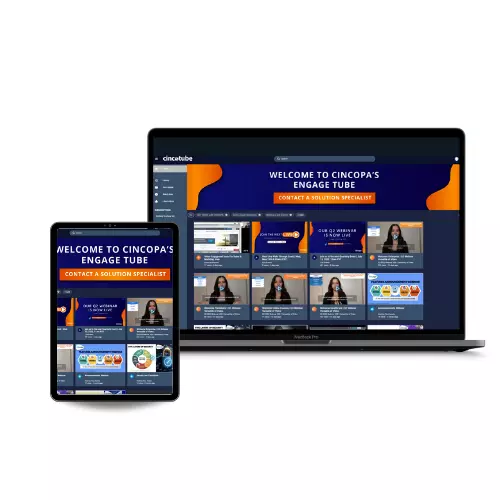
The content lifecycle involves creating, approving, and distributing digital assets. This can be a complicated process if digital assets are disorganized and hard to control and manage. Brands that manage to simplify the content publishing process will be more successful in a very competitive space.
Why publishing needs to be simple
Some problems you may face when publishing content are that it is time-consuming and procedures may be disconnected when digital assets are stored in many different places. A content publishing strategy requires efficient teamwork. For both small and large teams, it is essential that they have a comprehensive view when it comes to publishing content. An integrated view of operations shows how processes in one area of an organization affect other areas.

Content on its own is not enough – it has to achieve business goals and meet audience expectations. In order to achieve this, it is important to keep digital assets centralized to make workflow simple. Centralization of digital assets allows all teams to coordinate efficiently and maintain a consistent brand image.
Steps to simplify your publishing process
The first step to simplifying your publishing process is to centralize all your assets in one place. This enables you to control and manage them, use them efficiently, analyze their use, and make continuous improvements.

1. Put all your digital assets in one place
As your digital assets start to increase, you may find you have multiple storage solutions. Data inconsistency occurs when different versions of content exist in different places. You may find that outdated and duplicated content starts to clutter up your storage space. Your teams have to spend too much time searching for what they need to use. They have trouble keeping track of digital assets and using them efficiently.
At this stage, you need to consider a more advanced storage system with features that help you to manage your digital assets. You need to have a way to keep them organized, accessible and up to date.
Digital asset management systems (DAMs) make publishing, sharing and updating digital content easy so your teams can be more efficient.
When digital assets are well organized, the search functionality enables users to find what they need quickly and easily. Labeling and tagging assets correctly helps with finding them. When teams all use an agreed vocabulary for labeling and tagging, it helps to maintain consistency – whether it’s project names or campaign-specific keywords. Metadata is descriptive data that gives information about digital assets, and complete metadata makes searching for assets much faster.
CincoTube from Cincopa is a platform where all files can be centralized in one space. Users find it easy to access videos, images, podcasts, and other file types when they need to use them. Employees can spend more time on high-value activities than on trying to find the right digital assets for the right purpose.
2. Host, pre-record and live stream
You need to choose a platform that allows you to host, pre-record and live stream videos. Pre-recorded video is great for many different purposes. Creating great pre-recorded video content requires well-constructed scripts, sets, and editing after production.
Live streaming is becoming increasingly popular due to its spontaneous nature. Live streaming is more interactive than pre-recorded video, and as it isn’t changed or edited, it helps to build authenticity and trust. It also generally costs less to produce than pre-recorded video.

When it comes to live streaming, most social media platforms demand exclusivity from their users. You can opt to use a free solution, such as Facebook Live, but you need a more comprehensive solution if you want to ensure optimal streaming and more security.
Using a third-party video hosting platform allows you to stream to multiple channels at the same time so you can capitalize on the strength of each one. You can easily schedule pre-recorded live streams to go live across various channels simultaneously so you can spend time engaging with your audience.
3. Track viewers & develop analytics
It’s essential when managing your digital assets to have the ability to track viewers and measure engagement with actionable analytics. Understanding audience reaction to your digital assets is the key to successful marketing.

Analytics help you to find out more about specific users, such as their location, IP address, viewing time, platform, and average engagement.
Digital asset management platforms often have a dashboard where you can see aggregated stats within a specific time frame. When data is presented in graph form, it helps you to understand how dynamics change. Video heatmaps can help you to make sense of how viewers engage and where drop-offs happen.
With access to detailed analytics, you can optimize videos, identify what is of most interest to viewers, and produce more engaging content.
4. Control & manage projects in one space
When digital assets are in one place, you can establish user-based permissions. This gives you control over who can upload assets. You can make sure different teams only use the assets relevant to their role or task. Detecting duplicates is easy when assets are all in one place too.

Centralization makes it easier to ensure that your brand image remains consistent despite digital assets being distributed across many different channels. You have more control over customization to ensure that your brand image comes across in the same way across all of your assets.
Controlling and managing projects in one space also provides better security. You need to be able to share digital assets securely across an organization, and this is even more important today when many employees work remotely. You can allow authorized users access to digital assets they need and restrict access to others.
5. Invite contributors to upload
Some of the most important content brands can use is user-generated content. Websites such as Facebook and YouTube are popular because they allow users to upload their own content and engage with other users’ content.

When choosing a platform to centralize your digital assets, you should consider one that allows you to invite contributors to create, publish, share their own content and engage with other users’ content.
CincoTube – for Digital Publishers
CincoTube is a videotube that allows you to manage all your digital assets in one place. You can host, pre-record and live stream videos. It has private and public channels, which are virtual spaces to upload media assets.
Owners can add a workspace and create a video channel, add or remove content, invite users and set roles. Administrators can add or remove the content in a channel, change the channel’s name and description, change its privacy, and invite users to contribute or view content. 
Customization is easy on CincoTube. For example, you can simply select a color or input your color code to customize your videotube.
Owners and administrators can invite contributors to add content to a channel in CincoTube. Contributors can add or delete content but have no other access. Viewers have read-only access and cannot add digital assets.
Conclusion
Simplifying the process of content creation is very important for content publishers. The best way to do this is to store all digital assets in one place. Centralization of digital assets helps with controlling and managing them. Everyone has easy access, there’s more brand consistency, more security and greater productivity.









